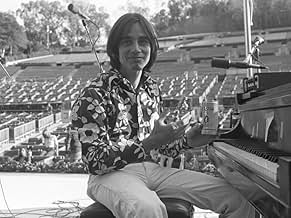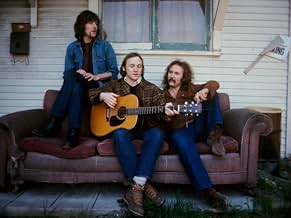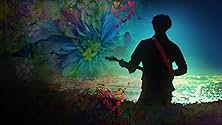IMDb RATING
8.2/10
1.4K
YOUR RATING
Documentary pulls back the curtain on a mythical world and provides an up-close look at the lives of the musicians who inhabited Laurel Canyon. It paints an intimate portrait of the artists ... Read allDocumentary pulls back the curtain on a mythical world and provides an up-close look at the lives of the musicians who inhabited Laurel Canyon. It paints an intimate portrait of the artists who created a music revolution that would change popular culture.Documentary pulls back the curtain on a mythical world and provides an up-close look at the lives of the musicians who inhabited Laurel Canyon. It paints an intimate portrait of the artists who created a music revolution that would change popular culture.
- Nominated for 3 Primetime Emmys
- 2 wins & 7 nominations total
Browse episodes
Featured reviews
This really is essential and must-see if you have any interest in the popular music that was created in the mid-60's - mid-70's in Southern California, specifically, the artists who lived in the Laurel Canyon area. I'm not an expert in this, but I am pretty knowledgeable about it, so it's always a treat when I learn about things for the first time that I didn't already know. A mild criticism of this movie was that it spent precious time on Little Feat, which was noted in the documentary itself that they were not a very popular or well-known group. The movie also reminded me of how great Linda Ronstadt was before she made the puzzling decision to start singing songs from the Big Band Era.
If you like this movie, I would also recommend 2008's, "The Wrecking Crew" about the unknown session musicians of that era who were responsible for helping to make many of the classic songs that came out of that time.
Finally, please note that this great documentary should not be confused with "Echo in the Canyon," Jakob Dylan's self-indulgent documentary that ostensibly was also about the Laurel Canyon era, but instead was mostly just him and his buddies doing covers of classic songs made famous by the original artists.
If you like this movie, I would also recommend 2008's, "The Wrecking Crew" about the unknown session musicians of that era who were responsible for helping to make many of the classic songs that came out of that time.
Finally, please note that this great documentary should not be confused with "Echo in the Canyon," Jakob Dylan's self-indulgent documentary that ostensibly was also about the Laurel Canyon era, but instead was mostly just him and his buddies doing covers of classic songs made famous by the original artists.
10dvh27
Amazing doc, loved the way it flowed, loved the way the narration was done with audio as opposed to having someone In the interview chair which definitely made it more romantic in my opinion. Yes a lot we have heard before but we have never heard it before in such a wonderfully mystical way. Loved it.
"It was just about a time, the creative awakening." ~ Jackson Browne
Allison Ellwood directed this two-part docuseries that covers the time and place where many of the top musicians of the day lived and hung out in a magical, semi-communal style life in the hills of California's Laurel Canyon in the heyday of the 1960s and early 1970s. As a child, I was transplanted from the midwest to the base of this fertile canyon and into this creative aura that permeated my soul.
The film moves fast, but not too fast, in a sumptuous display of picture and video images that tumble forward in accompaniment to the tunes and tales of beloved Troubadours.
Photographers Henry Diltz and Nurit Wilde, whose photographic contributions are seminal to documenting this tremendous time, both explain how they began taking pictures of the talented, photogenic folks on the cutting edge of the music and social scene to capture the moments they were part of. Over time, their photographic passions unfolded into stunning historical archives of this special time in the canyon and the reach these musicans had on the world.
This pleasureful project wove together individual stories I'd heard over the years with bits and bobs that were new to me. No matter how much you already know or not, this film offers a satisfying overview of the scene: David Crosby produced Joni Mitchell's first album in Florida and brought her to California where they landed in the rural canyon that runs as an artery through urban Los Angeles. Many of the artists-in-residence were hosted by, (and introduced to each other via), the exquisite, magnanimous "Mama" Cass Elliot of The Mamas & The Papas.
Crosby, Still, and Nash, and ultimately Young, hook up and go through various ups-and-down stages of their musical partnership. Linda Ronstadt and JD Souther have a cute meet and move in together, leading to love and creative collaboration; those in the orbit of luminous song stylist extraordinare, Linda, found themselves incarnating as a supergroup, The Eagles.
Graham Nash narrates his sweet story of how he and Joni Mitchell, then deep in domestic bliss, ate at Art's Deli on Ventura Blvd. one morning, after which Joni bought a vase she fancied, they returned to their canyon home, Joni went home to pick flowers to fill her new pretty purchase, and while she was out, her piano was empty and Graham presided over it and out spilled "Our House."
There is precious video of Eric Clapton listening gape mouthed to a fresh Joni play her unique guitar chords at a house party; Nurit Wilde adored taking photos of the affable Peter Tork, who had a penchant for nudity, and hosted pool parties at his haven in the hills; and one of my favorite moments is when Jackson Browne, the new kid, (then a georgous, cherub-faced young man), played "Song for Adam," for an impressed David Crosby, who dubbed Jackson part of the new wave of canyon musicians.
Apolitical young singer-songwriters found their voice during this transformative time. A seminal moment occured for Stephen Stills in 1966 when he witnessed the Sunset Strip curfew riots with violent clashes between police and the youth; he went home and wrote, "For What It's Worth."
In 1969, the moon landing was followed and juxtiposed by the Manson Murders; one positively electrifying event so far away, yet glowed larger than life in every living room in the country, and the other, awful events, so close by and negatively charged that they cast a gorey gloom over the graceful goodness of the days.
Groups and singers that brought country music into the rock fold were covered, as was The Monterey Pop Festival, and the move from playng intimate clubs like the Troubadour (where the artists could meet up, collaborate, and soak in each other's songs) to being booked at huge arenas, where larger audiences could enjoy the shows, but the cozy creativity of the Laurel Canyonites was lost.
The list of talent in the canyon included: Joni Mitchell; Crosby, Still, Nash & Young; Buffalo Springfield; The Byrds; The Mamas & The Papas; The Doors; Alice Cooper;The Monkees; Love; The Turtles; Jackson Browne; Linda Ronstadt; Little Feat; and The Flying Burrito Brothers. Steve Martin too!
I highly recommend this movie.
Allison Ellwood directed this two-part docuseries that covers the time and place where many of the top musicians of the day lived and hung out in a magical, semi-communal style life in the hills of California's Laurel Canyon in the heyday of the 1960s and early 1970s. As a child, I was transplanted from the midwest to the base of this fertile canyon and into this creative aura that permeated my soul.
The film moves fast, but not too fast, in a sumptuous display of picture and video images that tumble forward in accompaniment to the tunes and tales of beloved Troubadours.
Photographers Henry Diltz and Nurit Wilde, whose photographic contributions are seminal to documenting this tremendous time, both explain how they began taking pictures of the talented, photogenic folks on the cutting edge of the music and social scene to capture the moments they were part of. Over time, their photographic passions unfolded into stunning historical archives of this special time in the canyon and the reach these musicans had on the world.
This pleasureful project wove together individual stories I'd heard over the years with bits and bobs that were new to me. No matter how much you already know or not, this film offers a satisfying overview of the scene: David Crosby produced Joni Mitchell's first album in Florida and brought her to California where they landed in the rural canyon that runs as an artery through urban Los Angeles. Many of the artists-in-residence were hosted by, (and introduced to each other via), the exquisite, magnanimous "Mama" Cass Elliot of The Mamas & The Papas.
Crosby, Still, and Nash, and ultimately Young, hook up and go through various ups-and-down stages of their musical partnership. Linda Ronstadt and JD Souther have a cute meet and move in together, leading to love and creative collaboration; those in the orbit of luminous song stylist extraordinare, Linda, found themselves incarnating as a supergroup, The Eagles.
Graham Nash narrates his sweet story of how he and Joni Mitchell, then deep in domestic bliss, ate at Art's Deli on Ventura Blvd. one morning, after which Joni bought a vase she fancied, they returned to their canyon home, Joni went home to pick flowers to fill her new pretty purchase, and while she was out, her piano was empty and Graham presided over it and out spilled "Our House."
There is precious video of Eric Clapton listening gape mouthed to a fresh Joni play her unique guitar chords at a house party; Nurit Wilde adored taking photos of the affable Peter Tork, who had a penchant for nudity, and hosted pool parties at his haven in the hills; and one of my favorite moments is when Jackson Browne, the new kid, (then a georgous, cherub-faced young man), played "Song for Adam," for an impressed David Crosby, who dubbed Jackson part of the new wave of canyon musicians.
Apolitical young singer-songwriters found their voice during this transformative time. A seminal moment occured for Stephen Stills in 1966 when he witnessed the Sunset Strip curfew riots with violent clashes between police and the youth; he went home and wrote, "For What It's Worth."
In 1969, the moon landing was followed and juxtiposed by the Manson Murders; one positively electrifying event so far away, yet glowed larger than life in every living room in the country, and the other, awful events, so close by and negatively charged that they cast a gorey gloom over the graceful goodness of the days.
Groups and singers that brought country music into the rock fold were covered, as was The Monterey Pop Festival, and the move from playng intimate clubs like the Troubadour (where the artists could meet up, collaborate, and soak in each other's songs) to being booked at huge arenas, where larger audiences could enjoy the shows, but the cozy creativity of the Laurel Canyonites was lost.
The list of talent in the canyon included: Joni Mitchell; Crosby, Still, Nash & Young; Buffalo Springfield; The Byrds; The Mamas & The Papas; The Doors; Alice Cooper;The Monkees; Love; The Turtles; Jackson Browne; Linda Ronstadt; Little Feat; and The Flying Burrito Brothers. Steve Martin too!
I highly recommend this movie.
In the years this documentary covers, I went from 15 to 25. I listened to these songs on the radio, bought the albums, and went to the concerts. It was a time of explosive creativity in pop music of all kinds, from England to Motown to Nashville to San Francisco and L. A., and Laurel Canyon was the epicenter of everything happening in L. A. As the documentary shows, the singer/songwriters and bands all found their way to a close knit community, where they fed each other's creative juices, and made a lot of memorable music. Clearly it was quite a project, as there are interviews from many years past with artists long dead. It was great to see one of my favorite bands, Love, get a fair amount of attention, but I don't see how the band Spirit got no mention at all. They did some of the most creative music of the time, and their guitarist, Randy California, invented various devices that are now incorporated into every electric guitar made. The band's chief composer, Jay Ferguson, is still doing tv and movie scores today.
Highly recommended, especially for those of you unaware of what went on in that place at that time.
If you're a fan of music from the mid 60's to the early 70's this 2 part documentary is a fantastic insight from people who witnessed how a small community of hopeful musicians became world renowned from the first wave of The Byrds finding success by Bob Dylan's backing vocals singing out of tune to the second wave and the likes of the Eagles dominating the radio airwaves across the world.
I really wish this time capsule could of been made longer but as a fan seeing and hearing how the connection's between young hopefuls spark into some of the greatest music ever written and recorded.
A truly magical time shown it great detail , which leaves you thinking just how much the world could do with a repeat of the 'Laurel Canyon' vibe springing up some in today's music machine
Making music for musics sake not just to make money for the suits in an office
Did you know
- ConnectionsFeatured in The 2020 Primetime Creative Arts Emmy Awards (2020)
- How many seasons does Laurel Canyon have?Powered by Alexa
- I missed Laurel Canyon, Part 1 on May 31. How can I watch it?
Details
- Release date
- Country of origin
- Official site
- Language
- Also known as
- Laurel Canyon: A Place in Time
- Filming locations
- Production companies
- See more company credits at IMDbPro
- Runtime1 hour 18 minutes
- Color
- Sound mix
- Aspect ratio
- 1.78 : 1
Contribute to this page
Suggest an edit or add missing content




































